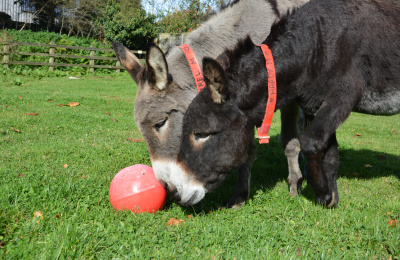Ben Hart, our Senior Lead in Behaviour and Human Behaviour Change, examines how our own actions and language can influence a donkey’s behaviour
Apart from pain and medical conditions, a donkey’s environment has the most significant influence on its behaviour. If the environment creates stress, frustration or anxiety, this could create emotional states that lead to behaviours such as biting themselves or other donkeys.
Donkeys need to socialise with suitable companions. They need the freedom to roam and move to satisfy their need to explore and exercise. Donkeys need suitable forage because what a donkey eats – how much, when, where, the variety and the competition for food – influences behaviour.
Shelter, water, weather, other animals and human behaviour are just a few of the other environmental influences that affect a donkey’s behaviour.
But even if a donkey has friends and freedom to roam, they still need additional enrichment to engage the mind. Donkeys who can channel energy into enrichment exercises are likely to be calmer and more content. Establishing the enrichment levels in a donkey’s environment tells us a lot about how donkeys spend their time.
Mind your language
The language we use forms an essential element of this ‘behaviour in everything’ approach. Language causes us to look at behaviour in different ways. For example, ‘stubborn’ is a word that you hear used to describe donkey behaviour, but that’s not the case.
Behaviour that people perceive as stubborn is a mixture of the donkey’s natural evolutionary tendencies to freeze when they are frightened, their limited body language signals and the fact that they have a fantastic sense of self-preservation.
When you combine these three elements, we can understand the error people make when they label donkeys this way. Labelling a donkey as stubborn is likely to reduce the handler's patience and stop them from looking for the real cause of the donkey’s behaviour.
Our mental perceptions create the language we use to describe behaviour, and the language we use determines how we interact or train our donkeys and mules.
Perfect timing
Being aware of the timing of our interaction is vital for good communication. For example, are we accidentally rewarding unwanted behaviour, as we absentmindedly scratch or stroke our donkey for nudging, nibbling or even nipping?
Behaviour is in every interaction; donkeys learn from us every time we are around them. Behaviour issues often have several contributing factors, so to find the solution we have to explore the effects of everything on the donkey’s behaviour.
Ways to use the concept of ‘behaviour in everything’ with donkeys or mules
- Stop for a moment and consider the friends, freedom and forage your donkeys have. How can you make these even better?
- Be aware of the timing of your interactions and ensure you are not accidentally rewarding unwanted behaviours
- Pay attention to the language you use to describe your donkey and their behaviour.
If this video doesn't show, it may be because your cookie settings need updating. Manage your cookie settings.




